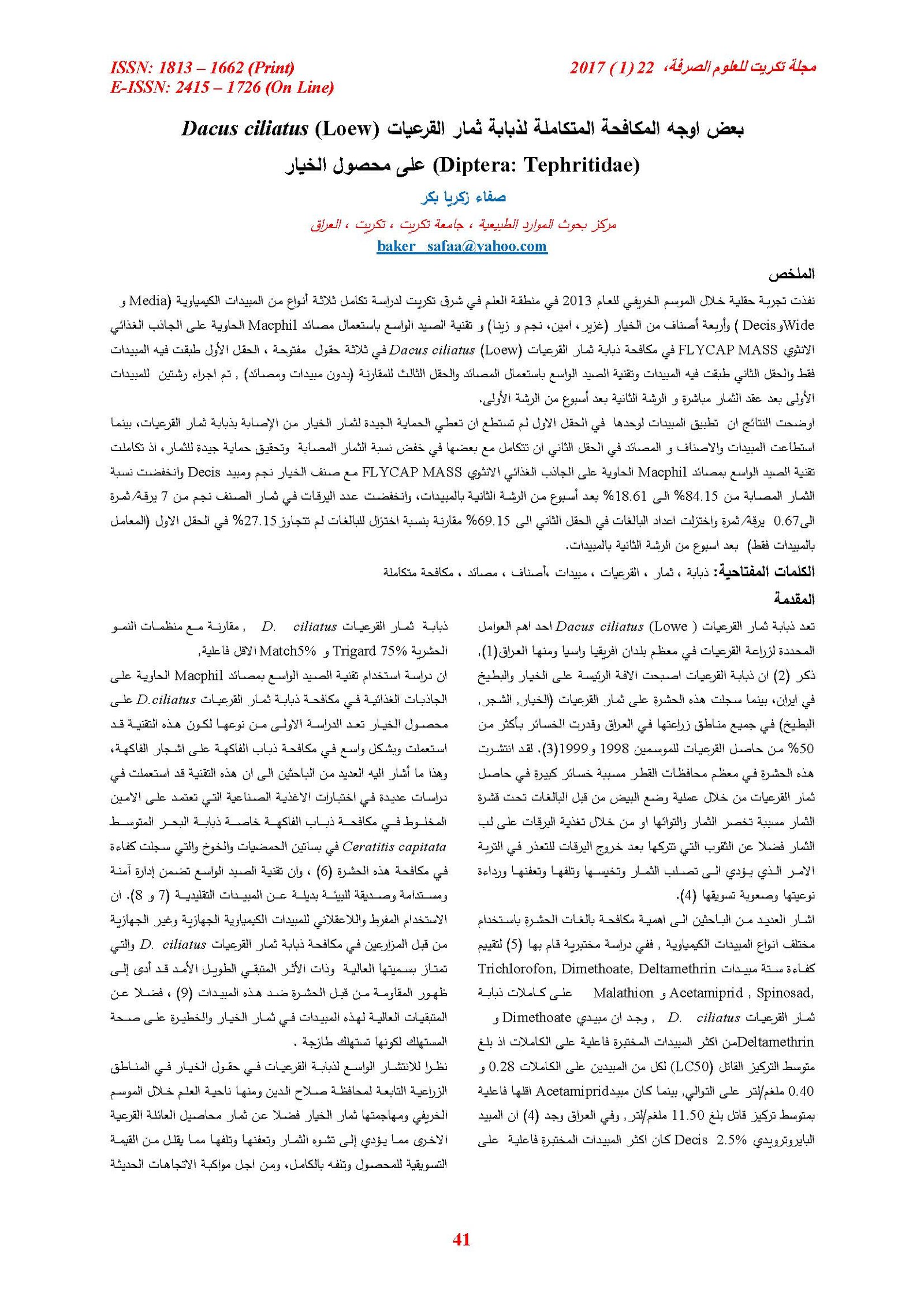Some aspects of the integrated control of cucurbits fruit fly Dacus ciliatus (Loew) (Diptera: Tephritidae) on cucumber crop
Main Article Content
Abstract
Field experiment was carried out during the autumn season in the Alam area in the east of Tikrit to study the integration of the three types of chemical pesticides (Media, Wide and Decis) and four cucumber varieties (Gazer, Amin, Najim and Zena) and Mass trapping technique by using Macphil traps that they contained female food attractive FLYCAP MASS to control cucurbits fruit fly Dacus ciliatus (Loew) in three open fields, the first field applied pesticides only, the second field applied pesticides and Mass trapping technique traps, and the third field for comparison (without pesticides and traps), was conducted two sprays for pesticides, the first spray after fruits setting directly and the second spray after week of the first spray .
Results showed that the application of pesticides alone in the first field had not been able to give good protection to the cucumber fruits from injury with cucurbits fruit fly Dacus ciliatus while the treatment of pesticides , varieties and Macphil traps in the second field that integrated each other in reducing the percentage of infected fruits to achieve good protection of the fruits and they showed that Integration between Mass traping technique by using Macphil traps that they contained FLYCAP MASS and Najim variety and Decis pesticide gave lower infected fruits percentage from 84.15% to 18.61% after one week of second spray, and reduce the number of larvae in Najim variety fruits from 7 Larva / fruit to 0.67 Larva / fruit and they reduced numbers of adults in the second field to 69.15% compared with the reduction percentage of the adults did not exceed 27.15% in the first field (treated with pesticides only) after one week of second spray.
Article Details

This work is licensed under a Creative Commons Attribution 4.0 International License.
Tikrit Journal of Pure Science is licensed under the Creative Commons Attribution 4.0 International License, which allows users to copy, create extracts, abstracts, and new works from the article, alter and revise the article, and make commercial use of the article (including reuse and/or resale of the article by commercial entities), provided the user gives appropriate credit (with a link to the formal publication through the relevant DOI), provides a link to the license, indicates if changes were made, and the licensor is not represented as endorsing the use made of the work. The authors hold the copyright for their published work on the Tikrit J. Pure Sci. website, while Tikrit J. Pure Sci. is responsible for appreciate citation of their work, which is released under CC-BY-4.0, enabling the unrestricted use, distribution, and reproduction of an article in any medium, provided that the original work is properly cited.
References
2-Arghand B. (1983). Introduction in cucumber fly Dacus spp. and primary investigation of it in Hormozgan province. Appl Entomol Phytopathol, 51:3-11.
5- Mahmoudvand, M; Garjan, A.S.; Rahimi, H.; Nezhad, A.R.A.; Mohajeri, M. E.; Mohammadipoo, A and Fazel, M.M. (2011). Susceptibility of Males and Females of Cucumber Fruit Fly, Dacus ciliatus, to Various Insecticides in the Laboratory Conditions. Jordan Journal of Biological Sciences.4(4): 213 – 218.
6- Bouagga,S. , Nayem Hassan2, Adel Jammazi3, and Monia B.H. Kame l4. (2012). Evaluation of ceranock attract and kill and Femilure Mass Trapping Strategies to Combat Mediterranean Fruit Fly Ceratitis capitata in Tunisia.Tunisian Journal of Plant Protection 7(2) :67-75.
7- Hassan M.N., Al-Zaidi S., and Ezekari M. (2010). Development of semiochemical based management strategy for Mediterranean fruit fly Ceratitis capitata in Citrus groves in Morocco. IOBC/wprs Bulletin Integrated control in Citrus fruit crops, 62: 181-182.
8- Nayem, H. Bouagga S., Kamel, M.B.H Jammazi, A. (2013) Evalution of Ceranock attractant and kill and femilure mass trapping strategies to combat Mediterranean fruit fly, Ceratitis capitata in Tunisia, IOBC WPRS Integrated Control in Citrus Fruit Crops, Adana, Turkey, May 7-9, , p. 13.
9- Vontas J, Hernández - Crespo, P, Margaritopoulos, JT, Ortego, F, Feng, H-T, -
Mathiopoulos, K, D, and Hsu J-C.. (2011) Insecticide resistance in Tephritid Flies, Pesticide Biochemistry and Physiology. 100(3): 199–205.
10- Katsoyannos, B.I. and Papadopoulos, N.T. (2004). Evaluation of synthetic female attractants against Ceratitis capitata (Diptera: Tephritidae) in sticky coated Spheres and McPhail type traps. J. Econ. Entomol, 97(1): 21-26.
12- SAS. (2004.) SAS/STAT User’s Guide for Personal Computers . Release 7.0 SAS Institute Inc. , Cary , N. C. , USA .
14-Abbott W.S. (1925). A method for computing the effectiveness of the insecticide. .J. Econ. Entomol, 18: 265-267.
15- Maklakov; A.; Ishaaya, I.; Friedberg A.; Yawetz A.; Horowitz A. R. and Yarom. (2001). Toxicological studies of organophosphate and pyrethroid Insecticides for controlling the fruit fly Dacus ciliatus(L) (Diptera:Tephritidae Econ. Entomol. 94(5):1059-1066 .
17- Cates, R.G. (1980). Feeding patterns of monophagous, oligophagous, and polyphagous insect herbivores: the effect of resource abundance and plant chemistry. Oecologia 46: 22-31.
18- Gogi, Muhammad Dildar, Muhammd Ashf Aq1, Muhmmad Jalal Arif1* and Muhammad Aslam Khan. (2010). Bio-phyasical bases of antixinotic mechanism of resistance in bitter-gourd (momrdica) charantia L., cucurbitcae against melon fruit fly, Bactrocera cucurbitae (coquilett) (Diptera: Tephritidae). Pak. J. Bot., 42(2): 1251-1266.
19- Verghese, A., Soumya, C. B.., Shivashankar, S., Manivannan1, S. and Krishnamurthy, M, (2012). Phenolics as chemical barriers to female fruit fly, Bactrocera dorsalis (Hendel) in mango. Current Science. 103(5):563-566.
20- El-Sayed A.M., Suckling D. M., Byers J.A., Jang. E.B. and Wearing C.H. (2009). Potential of “Lure and Kill” in long-term pest management and eradication of invasive species. J. Econ. Entomol, 102(3): 815-835.
21- Brockerhoff, E.G. and Suckling, D.M. (1999). Development of an attracticide Against light brown apple moth (Lepidoptera: Tortricidae). J. Econ. Entomol, 92: 853-859. 22- Bouagga S. (2012). Evaluation of various attractant-mediated systems to combat the Mediterranean fruit fly Ceratitis capitata on peach in Tunisia. Thesis Master of Science: Integrated pest Management of Mediterranean Fruit Flies. Agronomic Institute of Bari (IAMB), Bari, Italy.
